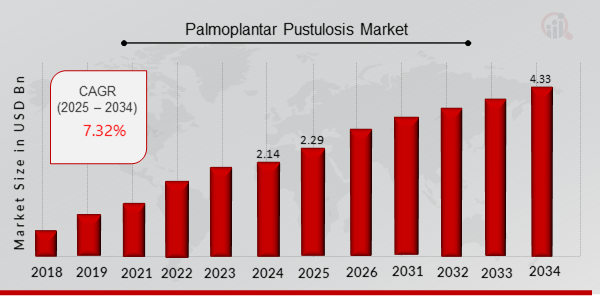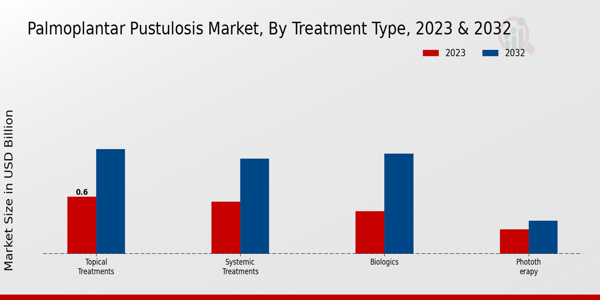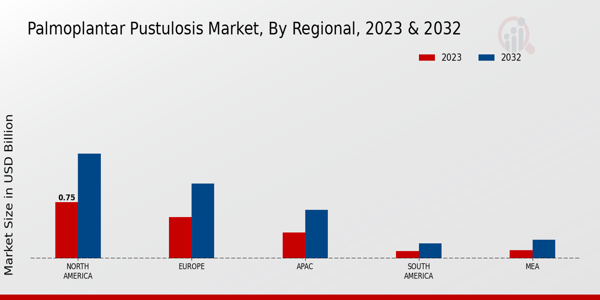Palmoplantar Pustulosis Market Overview
As per MRFR analysis, the Palmoplantar Pustulosis Market Size was estimated at 2.14 (USD Billion) in 2024. The Palmoplantar Pustulosis Market Industry is expected to grow from 2.29 (USD Billion) in 2025 to 4.33 (USD Billion) till 2034, at a CAGR (growth rate) is expected to be around 7.32% during the forecast period (2025 - 2034).
Key Palmoplantar Pustulosis Market Trends Highlighted
The growing concern over skin disorders and diseases supports the expansion of the Palmoplantar Pustulosis Market. The rising prevalence of palmoplantar pustulosis, a chronic disease of the skin marked by the presence of pimples in palms and soles, is causing healthcare practitioners to look for appropriate treatments. In addition, Dermatology as a specialty is being enhanced through targeted therapy development which further augmented the market growth. On the other hand, the rising popularity of customized treatments has made it necessary for pharmaceutical companies to find novel approaches that meet the condition's requirements. It was proposed that market participants attempt to develop new therapeutic strategies to enhance and broaden their product range.
The possibility of developing new drugs or biologics for the potential treatment of palmoplantar pustulosis is a considerable area for expansion. A collaborative effort with research institutions can lead to the development of combination treatments in order to adopt synergistic effects. In addition, the development of new economies provides companies with the opportunity to meet hitherto unfulfilled demand through raising the profile and availability of the treatments. There is a growing emphasis in the present environment on managing healthcare within a broader and more patient-focused business strategy. Treatment of patients focuses not only on the elimination of the disease but the improvement of the quality of life of the patient. Digital health innovations and telemedicine in the treatment of chronic skin diseases are expanding such that patients can interact and be managed even from the comfort of their homes.
This trend toward easier access to healthcare services is likely to change how treatments are delivered. Overall, the market is poised for innovation as it adapts to evolving patient needs and preferences while addressing the persistent challenges associated with palmoplantar pustulosis.

Source: Primary Research, Secondary Research, MRFR Database and Analyst Review
Palmoplantar Pustulosis Market Drivers
Increasing Incidence of Skin Disorders
The increasing prevalence of skin disorders, particularly palmoplantar pustulosis, is a significant driver for the Palmoplantar Pustulosis Market Industry. As more individuals are diagnosed with this chronic condition, the demand for effective treatment options is expected to rise. Factors contributing to the increase in skin disorders include environmental influences, lifestyle changes, and genetic predispositions. With the rise in awareness regarding skin health, healthcare providers are focusing on early diagnosis and intervention.
This shift in approach has catalyzed growth in the market as patients seek advanced therapies to manage symptoms effectively. Moreover, the rise in the population aged over 40 years, who are more susceptible to skin conditions, is expected to fuel demand in the Palmoplantar Pustulosis Market Industry. Therapies that were once limited in scope are now expanding due to research advancements, leading to the development of innovative treatment modalities.The growing emphasis on personalized medicine also plays a role in this trend, as patients increasingly seek tailored solutions to manage their conditions effectively. Notably, as healthcare systems evolve to accommodate a growing patient base, there is a push for the integration of more comprehensive care plans that include psychological support for individuals suffering from this chronic illness. This overall holistic approach to management grants patients a better quality of life and ultimately boosts market growth.
Advancements in Treatment Options
Recent advancements in treatment options are significantly driving growth within the Palmoplantar Pustulosis Market Industry. The introduction of biologics and targeted therapies has transformed the management landscape for patients suffering from this condition. These innovative treatments offer more effective and tailored responses for individual patients, leading to higher satisfaction rates. Moreover, the development of new topical agents and systemic treatments has expanded the therapeutic arsenal available to healthcare providers, enabling them to cater to diverse patient needs.As research continues to innovate, the market is likely to see even greater expansion, making effective treatments more accessible to those in need.
Increasing Research and Development Activities
The surge in research and development activities focused on skin diseases, especially palmoplantar pustulosis, is another key market driver. As pharmaceutical companies invest heavily in R, the potential for new drug discoveries and therapies emerges, fostering competitive advantage within the Palmoplantar Pustulosis Market Industry. This ongoing investment in research not only leads to novel treatment modalities but also enhances understanding of the disease pathology, paving the way for improved patient outcomes.Increased collaboration between academic institutions and biotech firms further accelerates innovation, driving market growth.
Palmoplantar Pustulosis Market Segment Insights
Palmoplantar Pustulosis Market Treatment Type Insights
The Palmoplantar Pustulosis Market segment, focusing on Treatment Type, showcases a diverse array of approaches intended to manage this particular dermatological condition. In 2023, the overall market reached a valuation of 1.86 USD Billion, with forecasts indicating substantial growth in subsequent years. Within this segment, Topical Treatments represent a major component of the landscape, with a valuation of 0.6 USD Billion in 2023 and projected to grow to 1.1 USD Billion by 2032. The importance of Topical Treatments lies in their direct application, offering localized relief and accessibility to patients, making them a popular choice among healthcare providers.Systemic Treatments follow closely, valued at 0.55 USD Billion in 2023 and expected to reach 1.0 USD Billion in 2032. These treatments are significant as they address the systemic nature of Palmoplantar Pustulosis, targeting the underlying causes rather than just symptoms, which adds to their efficacy and patient adherence. The Biologics segment is also notable, valued at 0.45 USD Billion in 2023 and expected to rise to 1.05 USD Billion by 2032. This treatment type hinges on advanced molecular therapies that modulate immune responses.
Hence, it is becoming increasingly prevalent as patients seek innovative solutions.On the other hand, Phototherapy, while experiencing growth, is valued at 0.26 USD Billion in 2023, with projections for an increase to 0.35 USD Billion by 2032, representing a more niche but critical option for certain patient populations. The overall trends within the Palmoplantar Pustulosis Market reflect a drive toward more personalized treatment options that cater to varying patient needs and conditions. With increasing awareness and diagnosis, the market is poised for significant advancement, driven by innovations in treatment methods and growing research efforts.The Palmoplantar Pustulosis Market revenue is likely to see heightened emphasis on these Treatment Types as patients and healthcare systems alike strive for more effective and responsive care solutions. Overall, the diverse strategies seen in this segment collectively align to position the Palmoplantar Pustulosis Market as a dynamic and evolving field focused on advancing patient outcomes.

Source: Primary Research, Secondary Research, MRFR Database and Analyst Review
Palmoplantar Pustulosis Market End User Insights
The Palmoplantar Pustulosis Market shows a strong presence across various End-user segments, including hospitals, dermatology clinics, and homecare settings, contributing to its overall valuation of 1.86 billion USD in 2023. Hospitals play a crucial role in this market as they offer comprehensive treatment options and access to advanced technologies, making them a primary point of care for patients. Dermatology clinics are significant due to their focused expertise in skin-related ailments, providing specialized treatments that cater specifically to palmoplantar pustulosis, thus driving patient preference for these facilities.Additionally, homecare settings are gaining traction as they offer convenience and comfort for patients managing chronic conditions like palmoplantar pustulosis at home, reflecting a changing trend towards personalized care. The strong growth trajectory of the Palmoplantar Pustulosis Market is influenced by an increasing prevalence of the condition, along with an aging population seeking effective treatment solutions. The combination of these factors contributes to a dynamic landscape in the Palmoplantar Pustulosis Market segmentation while also highlighting the opportunities and challenges within this evolving industry framework.
Palmoplantar Pustulosis Market Drug Type Insights
The Palmoplantar Pustulosis Market is significantly shaped by the Drug Type segment, which encompasses both Prescription Drugs and Over-the-Counter Drugs. In 2023, the overall market was valued at 1.86 USD Billion, reflecting the growing demand for effective treatment options for palmoplantar pustulosis. Prescription Drugs have emerged as a crucial component, often providing more potent therapeutic solutions that can significantly improve patient outcomes. On the other hand, Over-the-Counter Drugs offer greater accessibility and convenience for patients seeking immediate relief from symptoms.Evolving consumer preferences for tailored and efficient treatment solutions underscore the importance of these categories. Market growth is driven by advancements in drug formulations and a better understanding of palmoplantar pustulosis. Additionally, the rise in healthcare expenditure and increasing awareness about the condition contribute to the dynamics of the Palmoplantar Pustulosis Market segmentation. However, challenges such as pricing pressures and stringent regulatory requirements may impact market growth. Overall, the landscape of the Palmoplantar Pustulosis Market is characterized by ongoing innovation and a concerted effort to meet the diverse needs of patients.
Palmoplantar Pustulosis Market Distribution Channel Insights
The Palmoplantar Pustulosis Market, valued at 1.86 billion USD in 2023, highlights the critical role of distribution channels in enhancing accessibility and treatment options for patients. The distribution channels are divided among various platforms, including online pharmacies, retail pharmacies, and hospitals. Online pharmacies have gained significant traction due to their convenience and increased adoption of telehealth services, which are essential during the ongoing digital transformation in healthcare. Retail pharmacies remain vital, providing immediate access to necessary treatments and supporting local healthcare needs.Hospitals play a crucial role, being the primary point of care where patients with Palmoplantar Pustulosis receive specialized treatments and comprehensive management of their condition. This landscape is further influenced by trends such as rising consumer demand for easy access to healthcare products, increasing awareness about Palmoplantar Pustulosis, and expanding healthcare infrastructure, which collectively drives the Palmoplantar Pustulosis Market revenue and signify the importance of a multi-channel approach for effective distribution and support in the market.
Palmoplantar Pustulosis Market Regional Insights
The Palmoplantar Pustulosis Market is characterized by a diverse regional segmentation that significantly influences overall market dynamics. In 2023, North America led the market with a valuation of 0.75 USD Billion, showcasing a substantial demand for treatment options and therapies, indicating a majority holding that drives innovation and research. Europe follows closely, valued at 0.55 USD Billion, reflecting a strong healthcare infrastructure and increasing awareness about skin diseases. The APAC region, valued at 0.35 USD Billion, is emerging as a significant player due to rising healthcare access and growing public awareness, likely fueled by population growth and dermatological needs.Meanwhile, South America and the MEA regions reflect smaller market sizes, valued at 0.1 USD Billion and 0.11 USD Billion, respectively, yet they express potential for future growth as healthcare initiatives intensify and economic conditions improve. As the overall market transitions from 2025 to 2034, these regional insights underscore the importance of strategic investments and localized approaches in addressing the needs of Palmoplantar Pustulosis patients worldwide.

Source: Primary Research, Secondary Research, MRFR Database and Analyst Review
Palmoplantar Pustulosis Market Key Players and Competitive Insights
The Palmoplantar Pustulosis Market is characterized by a complex, competitive landscape driven by varying factors that influence market growth and innovation. A pivotal area of interest within this market is the development of novel treatment options that address the unique challenges presented by palmoplantar pustulosis, a chronic inflammatory skin condition. Companies in this sector are focusing on advanced biologics, topical therapies, and systemic treatments to improve patient outcomes. The competitive dynamics are shaped by the presence of established pharmaceutical firms, emerging biotech companies, and a heightened emphasis on research and development tasks to bring effective therapies to market. This environment has drawn significant investments aimed at not only addressing current treatment gaps but also enhancing patient access and engagement.Eli Lilly and Company has strengthened its position within the Palmoplantar Pustulosis Market through its robust portfolio of treatments and continual innovation initiatives.
The company's commitment to research and development allows it to leverage cutting-edge technologies and novel therapeutic approaches, which have the potential to advance patient care significantly. Eli Lilly's strengths lie in its established reputation and expertise in managing chronic inflammatory conditions, reinforced by a strong pipeline of products designed to offer targeted relief and improve the quality of life for those affected by this skin disorder. Their global presence and dedication to expanding market access mean that they can effectively address diverse patient needs across various regions, maintaining a competitive edge in the marketplace.
Pfizer has also made notable contributions to the Palmoplantar Pustulosis Market, highlighting its commitment to addressing complex dermatological conditions. The company's varied product offerings, paired with its research depth, provide a significant advantage as it seeks to innovate and expand its therapeutic options. Pfizer's strengths include its expansive network and infrastructure, which enable rapid distribution and scalability of treatment solutions in various markets. With ongoing clinical trials and studies aimed at optimizing existing therapies and discovering new interventions, Pfizer remains firmly positioned to make impactful strides in the palmoplantar pustulosis space. The company's strategic focus on collaboration with healthcare professionals and institutions further enhances its understanding of patient needs and market demands, ensuring the development of relevant and effective treatment options.
Key Companies in the Palmoplantar Pustulosis Market Include
- Eli Lilly and Company
- Pfizer
- Amgen
- Celgene
- Teva Pharmaceuticals
- AbbVie
- Janssen Pharmaceuticals
- GSK
- Boehringer Ingelheim
- AstraZeneca
- Novartis
- Bristol-Myers Squibb
- Regeneron Pharmaceuticals
- Sanofi
- Merck and
Palmoplantar Pustulosis Market Industry Developments
Recent developments in the Palmoplantar Pustulosis Market indicate a growing focus on targeted therapies and biologics. Companies such as Eli Lilly and Company and AbbVie are expanding their portfolios, showcasing new treatment options that promise improved patient outcomes. There is increasing collaboration among key players like Pfizer and Amgen to enhance research and development efforts, addressing the unmet medical needs in this niche dermatological area. Current affairs suggest a trend towards personalized medicine, with Novartis and Regeneron Pharmaceuticals leading initiatives to incorporate genetic insights into treatment strategies.
Additionally, the market is witnessing significant growth in valuation as demand for effective therapies rises, notably impacting the strategies of companies like Celgene and Janssen Pharmaceuticals. In terms of mergers and acquisitions, AstraZeneca's recent acquisition of a biotech firm has attracted attention, demonstrating a strategic move to bolster their product offerings in immunology, which can extend to conditions like Palmoplantar Pustulosis. Overall, the concerted efforts among key players such as GSK, Boehringer Ingelheim, and Merck Co. reflect a dynamic market landscape poised for innovative developments.
Palmoplantar Pustulosis Market Segmentation Insights
Palmoplantar Pustulosis Market Treatment Type Outlook
- Topical Treatments
- Systemic Treatments
- Biologics
- Phototherapy
Palmoplantar Pustulosis Market End User Outlook
- Hospitals
- Dermatology Clinics
- Homecare Settings
Palmoplantar Pustulosis Market Drug Type Outlook
- Prescription Drugs
- Over-the-Counter Drugs
Palmoplantar Pustulosis Market Distribution Channel Outlook
- Online Pharmacies
- Retail Pharmacies
- Hospitals
Palmoplantar Pustulosis Market Regional Outlook
- North America
- Europe
- South America
- Asia-Pacific
- Middle East and Africa
| Report Attribute/Metric |
Details |
|
Market Size 2024
|
2.14 (USD Billion)
|
|
Market Size 2025
|
2.29 (USD Billion)
|
|
Market Size 2034
|
4.33 (USD Billion)
|
|
Compound Annual Growth Rate (CAGR)
|
7.32 % (2025 - 2034)
|
|
Report Coverage
|
Revenue Forecast, Competitive Landscape, Growth Factors, and Trends
|
|
Base Year
|
2024
|
|
Market Forecast Period
|
2025 - 2034
|
|
Historical Data
|
2020 - 2024
|
| Market Forecast Units |
USD Billion |
| Key Companies Profiled |
Eli Lilly and Company, Pfizer, Amgen, Celgene, Teva Pharmaceuticals, AbbVie, Janssen Pharmaceuticals, GSK, Boehringer Ingelheim, AstraZeneca, Novartis, Bristol-Myers Squibb, Regeneron Pharmaceuticals, Sanofi, Merck and Co. |
| Segments Covered |
Treatment Type, End User, Drug Type, Distribution Channel, Regional |
| Key Market Opportunities |
Increasing prevalence of palmoplantar pustulosis, Growing demand for effective therapies, Advancements in biological treatments, Rise in telemedicine applications, Expanding patient awareness campaigns |
| Key Market Dynamics |
Increasing prevalence of psoriasis, Growing awareness and diagnosis, Advancements in treatment options, Rising demand for biologics, Chronic nature of the disease |
| Countries Covered |
North America, Europe, APAC, South America, MEA |
Frequently Asked Questions (FAQ) :
The Palmoplantar Pustulosis Market is expected to be valued at 3.5 USD Billion in 2034.
The projected CAGR for the Palmoplantar Pustulosis Market from 2025 to 2034 is 7.3%.
North America is expected to have the largest market share, valued at 1.4 USD Billion in 2034.
The market for Topical Treatments is projected to grow to 1.1 USD Billion by 2034.
Major players in the market include Eli Lilly and Company, Pfizer, Amgen, and AbbVie.
The market size for Biologics is expected to reach 1.05 USD Billion by 2034.
The APAC region is expected to reach a market size of 0.65 USD Billion by 2034.
The projected market value for Systemic Treatments is anticipated to be 1.0 USD Billion in 2034.
The market size for Phototherapy is expected to grow to 0.35 USD Billion by 2034.
The market may face challenges from regulatory hurdles and competition among key players in the industry.

















